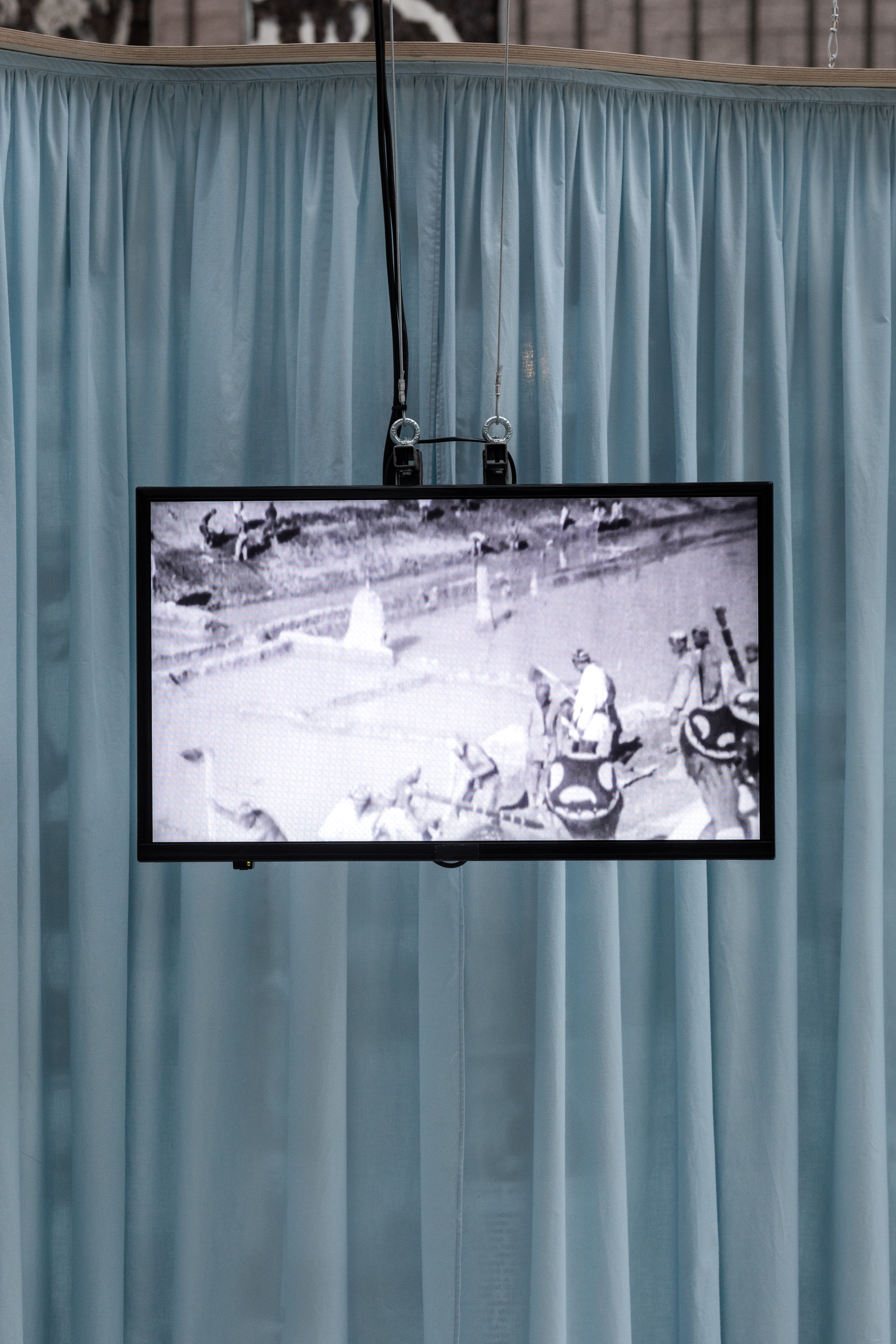DAVRA research group (Madina Joldybek, Zumrad Mirzalieva, Saodat Ismailova)
Work exhibited in the Trade Fair Palace:
Taming Women and Waters in Soviet Central Asia / 2024 / research-based multimedia installation / archival films (8 min), archival work (collage, print on fabric, 200 × 700 cm), photography series (each print 60 × 48 cm), textile works (embroidery, each 94 × 119 cm) / courtesy of the artists
* Commissioned by the Biennale Matter of Art Prague.
Taming Women and Waters in Soviet Central Asia, 2024, Biennale Matter of Art 2024, National Gallery Prague – Trade Fair Palace (c) Jonáš Verešpej
The new project of DAVRA research group for the biennale focuses on the Great Fergana Canal. This 270 km long canal between Uzbekistan and Tajikistan was built in just 45 days in 1939 by 160,000 workers. Its purpose was to bring water from the Syr Darya river to the cotton fields.
Cotton is known as the “white gold” of the region. The canal made it possible to produce cotton on a large, industrial scale. It became a symbol of progress in Soviet-era Central Asia. Today this dream of modernization has become a nightmare. It caused ecological damage that cannot be repaired. The Aral Sea has almost dried out because of the bad water management. Tensions between the neighboring countries are growing due to the lack of water. DAVRA looks for historical connections between the use and misuse of women’s work and water. The artists study how women danced the Cotton Dance (Paxta Raqsi) to motivate the men working on the construction of the canal, blurring the line between leisure and labor. They present their findings in different forms: films, photos, textile works, and archival material. The installation’s shape mirrors the shape of the Syr Darya River. DAVRA creates new portraits of the changing rivers in the Tashkent region and along the Fergana Valley. They transform cotton pickers’ aprons into sensitive collages to reimagine relations between water, women, dance and cotton.
DAVRA research group was founded in 2021 by Saodat Ismailova as an extension of her project Chilltan for documenta fifteen. The group initiates dynamic ex- changes of experience and knowledge within the Central Asian art scene.
DAVRA (Central Asia, est. 2021) looks for historical connections between the use and misuse of women’s work and water. The artists study how women danced the Cotton Dance (Paxta Raqsi) to motivate the men working on the construction of the canal, blurring the line between leisure and labor. They present their findings in different forms: films, photos, textile collages, and archival material. The installation's shape mirrors the shape of the Syr Darya River. Carefully re-edited film chronicles tell the story of how women and water were misused for industrial ends in cotton production. DAVRA creates new portraits of the changing rivers in the Tashkent region and along the Fergana Valley. They transform cotton pickers’ aprons into sensitive collages to re-imagine relations between water, women, dance and cotton.

DAVRA artist talk at the Hope Recycling Station symposium MAKE VOICES HEARD, December 2023, Prague (c) Tereza Havlínková
Madina Joldybek (London, b. Zhezkazgan (Kazakhstan), 1991); Zumrad Mirzalieva (Tashkent, b. Tashkent (Uzbekistan), 1997); Saodat Ismailova (Paris / Tashkent, b. Tashkent (Uzbekistan), 1981)
Members of the DAVRA group:
Madina Joldybek is a London-based multidisciplinary artist and educator originally from Kazakhstan. Her practice revolves around themes of bodily integrity, womanhood, multi-dimensional motherhood, and authoritarian regimes. Joldybek employs various mediums such as illustration, weaving, sculpture, and installation in her work. Selected exhibitions, institutions, and public programs that have showcased her work include Asia NOW in Paris, Tbilisi Art Fair, JOAN art space in Los Angeles, W3 Gallery in London, the Centre for Heritage, Arts, and Textile in Hong Kong, documenta fifteen in Kassel, Kingshill House in Dursley, Slavs and Tatars’ Pickle Bar in Berlin, Garage Museum, and Aspan Gallery in Almaty. Her work is part of the public collection at the Kasteev State Museum of Arts. Joldybek was the first laureate of the B. Bubikanova Art Prize.
Zumrad Mirzalieva is a photographer and filmmaker from Uzbekistan. She is a member of the DAVRA research group and a recent resident at Fabrica Research Centre. Holding a master’s degree in social innovation from the London School of Economics and Political Science, she has focused on exploring the transformative potential of art in driving positive social change. Mirzalieva’s artistic practice revolves around the exploration of interconnected themes, including decolonization, exploitation, ecology, agency, and rethinking historical narratives through an intersectional feminist perspective.
Saodat Ismailova is a filmmaker and artist who graduated from Tashkent State Art Institute in Uzbekistan and Le Fresnoy, National Studio of Contemporary Arts in France. Drawing on the cultural identities and vernacular histories of Central Asia, Ismailova’s films meditate on memory, spirituality, immortality, and extinction. Frequently based around oral stories in which women are the lead protagonists, while also exploring systems of knowledge suppressed by globalized modernity, these consciousness-expanding works hover between visible and invisible worlds. Ismailova initiated the DAVRA research group in Central Asia in 2021. In 2022 she participated in the 59th Venice Biennale and presented new work at documenta fifteen. In 2022, she received the Eye Art & Film Prize. Her new film Melted into the Sun is presented at the Nebula exhibition, commissioned by Fondazione In Between Art Film for the 2024 Venice Biennale. Her works can be found in the collections of the Stedelijk Museum Amsterdam, the Centre Pompidou in Paris, and others.
DAVRA research group (Madina Joldybek and Zumrad Mirzalieva) completed artist residency in Prague in 2023 and 2024, as part of the Biennale Matter of Art 2024, which was funded by the European Union – NextGenerationEU.






